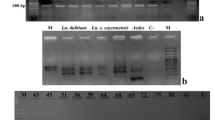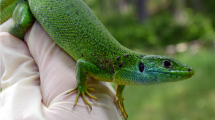Abstract
The genetic identity of Wolbachia endosymbiont in Rhipicephalus sanguineus ticks was determined for the first time in Taiwan. In total 1004 Rh. sanguineus ticks were examined for Wolbachia by polymerase chain reaction assay targeting the Wolbachia surface protein (wsp) gene. The prevalence of Wolbachia infection was detected in nymphs, females, and males with an infection rate of 55.8, 39.8, and 44%, respectively. The phylogenetic relationships were analyzed by comparing the sequences of wsp gene obtained from 60 strains of Wolbachia representing 11 strains of supergroup A and 10 strains of supergroup B. In general, seven major clades of supergroup A and six major clades of supergroup B can be easily distinguished by neighbour-joining analysis and were congruent by maximum likelihood method. All these Wolbachia strains of Taiwan were genetically affiliated to supergroups A and B with high sequence similarity of 98.3–100% and 98.6–100%, respectively. Intra- and inter-group analysis based on the genetic distance (GD) values indicated a lower level (GD < 0.017) within the group A strains of Taiwan compared with the group B (GD > 0.576) of other Wolbachia strains, as well as a lower level (GD < 0.062) within the group B strains of Taiwan compared with the group A (GD > 0.246) of other Wolbachia strains. Our results provide the first genetic identification of Wolbachia endosymbiont in Rh. sanguineus ticks collected from Taiwan, and detection of Wolbachia in male and nymphal ticks may imply the possible mechanism of transstadial transmission in Rh. sanguineus ticks.





Similar content being viewed by others
References
Andreotti R, Perez de Leon AA, Dowd SE, Guerrero FD, Bendele KG, Scoles GA (2011) Assessment of bacterial diversity in the cattle tick Rhipicephalus (Boophilus) microplus through tag-encoded pyrosequencing. BMC Microbiol 11(1):6
Baldo L, Prendini L, Corthals A, Werren JH (2007) Wolbachia are present in southern African scorpions and cluster with supergroup F. Curr Microbiol 55:367–373
Benson MJ, Gawronski JD, Eveleigh DE, Benson DR (2004) Intracellular symbionts and other bacteria associated with deer ticks (Ixodes scapularis) from Nantucket and Wellfleet, Cape Cod, Massachusetts. Appl Environ Microbiol 70(1):616–620
Bing XL, Xia WQ, Gui JD, Yan GH, Wang XW, Liu SS (2014) Diversity and evolution of the Wolbachia endosymbionts of Bemisia (Hemiptera: Aleyrodidae) whiteflies. Ecol Evol 4(13):2714–2737
Bordenstein S, Rosengaus RB (2005) Discovery of a novel Wolbachia super group in Isoptera. Curr Microbiol 51(6):393–398
Carpi G, Cagnacci F, Wittekindt NE, Zhao F, Qi J, Tomsho LP, Drautz DI, Rizzoli A, Schuster SC (2011) Metagenomic profile of the bacterial communities associated with Ixodes ricinus ticks. PLoS ONE 6(10):e25604
Chai HN, Du YZ, Qiu BL, Zhai BP (2011) Detection and phylogenetic analysis of Wolbachia in the Asiatic rice leafroller, Cnaphalocrocis medinalis, in Chinese populations. J Insect Sci 11:123
Chao LL, Yeh ST, Hsieh CK, Shih CM (2016) First detection and molecular identification of Babesia vogeli from Rhipicephalus sanguineus (Acari: Ixodidae) in Taiwan. Exp Appl Acarol 68:539–551
Chao LL, Liao HT, Ho TY, Shih CM (2017) First detection and molecular identification of Babesia gibsoni from Rhipicephalus sanguineus ticks. Acta Trop 166:356–362
Dantas-Torres F (2010) Biology and ecology of the brown dog tick Rhipicephalus sanguineus. Parasit Vectors 3:26
Dantas-Torres F, Chomel BB, Otranto D (2012) Ticks and tick-borne diseases: a One Health perspective. Trends Parasitol 28(10):437–446
Dutra HL, Rocha MN, Dias FB, Mansur SB, Caragata EP, Moreira LA (2016) Wolbachia blocks currently circulating zika virus isolates in Brazilian Aedes aegypti mosquitoes. Cell Host Microbe 19(6):771–774
Eremeeva ME, Zambrano ML, Anaya L et al (2011) Rickettsia rickettsii in Rhipicephalus ticks, Mexicali, Mexico. J Med Entomol 48:418–421
Felsenstein J (1985) Confidence limits on phylogenies: an approach using the bootstrap. Evolution 52:1119–1134
Felz MW, Durden LA, Oliver JH Jr (1996) Ticks parasitizing humans in Georgia and South Carolina. J Parasitol 82:505–508
Gerth M, Gansauge MT, Weigert A, Bleidorn C (2014) Phylogenomic analyses uncover origin and spread of the Wolbachia pandemic. Nat Commun 5:5117. https://doi.org/10.1038/ncomms6117
Goddard J (1989) Focus of human parasitism by the brown dog tick, Rhipicephalus sanguineus (Acari: Ixodidae). J Med Entomol 26:628–629
Hartelt K, Oehme R, Frank H, Brockmann SO, Hassler D, Kimmig P (2004) Pathogens and symbionts in ticks: prevalence of Anaplasma phagocytophilum (Ehrlichia sp.), Wolbachia sp., Rickettsia sp., and Babesia sp. in Southern Germany. Int J Med Microbiol 293(Suppl 37):86–92
Hertig M, Wolbach SB (1924) Studies on Rickettsia-like micro-organisms in insects. J Med Res 44(3):329–374
Hilgenboecker K, Hammerstein P, Schlattmann P, Telschow A, Werren JH (2008) How many species are infected with Wolbachia? A statistical analysis of current data. FEMS Microbiol Lett 281(2):215–220
Hoffmann AA, Montgomery BL, Popovici J, Iturbe-Ormaetxe I, Johnson PH, Muzzi F, Greenfield M, Durkan M, Leong YS, Dong Y, Cook H, Axford J, Callahan AG, Kenny N, Omodei C, McGraw EA, Ryan PA, Ritchie SA, Turelli M, O’Neill SL (2011) Successful establishment of Wolbachia in Aedes populations to suppress dengue transmission. Nature 476(7361):454–457
Huber D, Reil I, Duvnjak S, Jurkovic D, Lukacevic D, Pilat M, Beck A, Mihaljevic Z, Vojta L, Polkinghorne A, Beck R (2017) Molecular detection of Anaplasmaplatys, Anaplasmaphagocytophilum and Wolbachia sp. but not Ehrlichiacanis in Croatian dogs. Parasitol Res 116(11):3019–3026
Inokuma H, Raoult D, Brouqui P (2000) Detection of Ehrlichia platys DNA in brown dog ticks (Rhipicephalus sanguineus) in Okinawa Island. Japan J Clin Microbiol 38(11):4219–4221
Khoo JJ, Chen F, Kho KL, Ahmad Shanizza AI, Lim FS, Tan KK, Chang LY, AbuBakar S (2016) Bacterial community in Haemaphysalis ticks of domesticated animals from the Orang Asli communities in Malaysia. Ticks Tick Borne Dis 7(5):929–937
Kimura M (1980) A simple method for estimating evolutionary rate of base substitutions through comparative studies of nucleotide sequences. J Mol Evol 16:111–120
Kumar S, Stecher G, Li M, Knyaz C, Tamura K (2018) MEGA X: molecular evolutionary genetics analysis across computing platforms. Mol Bio Evol 35:1547–1549
Laven H (1967) Eradication of Culex pipiens fatigans through cytoplasmic incompatibility. Nature 216(5113):383–384
Lee CC, Hsieh YC, Huang CC, Tsang CL, Chung YT (2010) Sequence and phylogenetic analysis of the thrombospondin-related adhesive protein (TRAP) gene of Babesia gibsoni isolates from dogs in Taiwan. J Vet Med Sci 72(10):1329–1335
Mains JW, Brelsfoard CL, Rose RI, Dobson SL (2016) Female adult Aedes albopictus suppression by Wolbachia-infected male mosquitoes. Sci Rep 6:33846
Manfred MT, Dini V, Piacenza S et al (1999) Tick species parasitizing people in an area endemic for tick-borne diseases in north-western Italy. Parasitologia 41:555–560
Moreira LA, Iturbe-Ormaetxe I, Jeffery JA, Lu G, Pyke AT, Hedges LM, Rocha BC, Hall-Mendelin S, Day A, Riegler M, Hugo LE, Johnson KN, Kay BH, McGraw EA, van den Hurk AF, Ryan PA, O’Neill SL (2009) A Wolbachia symbiont in Aedes aegypti limits infection with dengue, Chikungunya, and Plasmodium. Cell 139(7):1268–1278
Moutailler S, Valiente Moro C, Vaumourin E, Michelet L, Tran FH, Devillers E, Cosson JF, Gasqui P, Van VT, Mavingui P, Vourc’h G, Vayssier-Taussat M (2016) Co-infection of ticks: the rule rather than the exception. PLoS Negl Trop Dis 10(3):e0004539
Otranto D, Dantas-Torres F, Breitschwerdt EB (2009) Managing canine vector-borne diseases of zoonotic concern: part one. Trends Parasitol 25(4):157–163
Parola P, Socolovschi C, Jeanjean L, Bitam I, Fournier PE, Sotto A, Labauge P, Raoult D (2008) Warmer weather linked to tick attack and emergence of severe rickettsioses. PLoS Negl Trop Dis 2(11):e338
Popovici J, Moreira LA, Poinsignon A, Iturbe-Ormaetxe I, McNaughton D, O’Neill SL (2010) Assessing key safety concerns of a Wolbachia-based strategy to control dengue transmission by Aedes mosquitoes. Mem Inst Oswaldo Cruz 105(8):957–964
Rowley SM, Raven RJ, McGraw EA (2004) Wolbachia pipientis in Australian spiders. Curr Microbiol 49:208–214
Silveira JA, Passos LM, Ribeiro MF (2009) Population dynamics of Rhipicephalus sanguineus (Latrielle, 1806) in Belo Horizonte, Minas Gerais state, Brazil. Vet Parasitol 161(34):270–275
Starkey LA, Newton K, Brunker J, Crowdis K, Edourad EJP, Meneus P, Little SE (2016) Prevalence of vector-borne pathogens in dogs from Haiti. Vet Parasitol 224:7–12
Thompson JD, Higgins DG, Gibson TJ (1994) CLUSTAL W: Improving the sensitivity of progressive multiple sequence alignment through sequence weighting, position-specific gap penalties and weight matrix choice. Nuc Acids Res 22:4673–4680
Tijsse-Klasen E, Braks M, Scholte EJ, Sprong H (2011) Parasites of vectors-Ixodiphagus hookeri and its Wolbachia symbionts in ticks in the Netherlands. Parasit Vectors 4:228
Turba ME, Zambon E, Zannoni A, Russo S, Gentilini F (2012) Detection of Wolbachia DNA in blood for diagnosing filaria-associated syndromes in cats. J Clin Microbiol 50(8):2624–2630
Uspensky I, Ioffe-Uspensky I (2002) The dog factor in brown dog tick Rhipicephalus sanguineus (Acari: Ixodidae) infestations in and near human dwellings. Int J Med Microbiol 291:156–163
Wang GH, Jia LY, Xiao JH, Huang DW (2016) Discovery of a new Wolbachia supergroup in cave spider species and the lateral transfer of phage WO among distant hosts. Infect Genet Evol 41:1–7
Walker JB, Keirans JE, Horak IG (2000) The Genus Rhipicephalus (Acari, Ixodidae): a guide to the brown ticks of the world. Cambridge University Press, Cambridge
Werren JH (1997) Biology of Wolbachia. Annu Rev Entomol 42:587–609
Werren JH, Baldo L, Clark ME (2008) Wolbachia: master manipulators of invertebrate biology. Nat Rev Microbiol 6(10):741–751
Werren JH, Zhang W, Guo LR (1995) Evolution and phylogeny of Wolbachia: reproductive parasites of arthropods. Proc Biol Sci 261(1360):55–63
Yuasa Y, Tsai YL, Chang CC, Hsu TH, Chou CC (2017) The prevalence of Anaplasma platys and a potential novel Anaplasma species exceed that of Ehrlichia canis in asymptomatic dogs and Rhipicephalus sanguineus in Taiwan. J Vet Med Sci 79(9):1494–1502
Zhang X, Norris DE, Rasgon JL (2011) Distribution and molecular characterization of Wolbachia endosymbionts and filarial nematodes in Maryland populations of the lone star tick (Amblyomma americanum). FEMS Microbiol Ecol 77(1):50–56
Zhou W, Rousset F, O’Neil S (1998) Phylogeny and PCR-based classification of Wolbachia strains using wsp gene sequences. Proc Biol Sci 265(1395):509–515
Zug R, Hammerstein P (2012) Still a host of hosts for Wolbachia: analysis of recent data suggests that 40% of terrestrial arthropod species are infected. PLoS ONE 7(6):e38544
Acknowledgements
This work was supported in part by grants from the Ministry of Science and Technology (MOST 108-2314-B-037-063; MOST 109-2314-B-037-077), Taipei, Taiwan, ROC.
Author information
Authors and Affiliations
Corresponding author
Ethics declarations
Ethical approval
The collection of ticks from dogs was assistant by veterinary practitioners and approved by the Institutional Animal Care and Use Committee (IACUC) of Kaohsiung Medical University (IACUC Approval No: 106142).
Additional information
Publisher's Note
Springer Nature remains neutral with regard to jurisdictional claims in published maps and institutional affiliations.
Rights and permissions
About this article
Cite this article
Chao, LL., Castillo, C.T. & Shih, CM. Molecular detection and genetic identification of Wolbachia endosymbiont in Rhipicephalus sanguineus (Acari: Ixodidae) ticks of Taiwan. Exp Appl Acarol 83, 115–130 (2021). https://doi.org/10.1007/s10493-020-00574-3
Received:
Accepted:
Published:
Issue Date:
DOI: https://doi.org/10.1007/s10493-020-00574-3




